Contents
- 1. Users Manual
- 2. User Information
Users Manual
♦ TABLE OF CONTENTS
TABLE OF CONTENTS
LIST OF ILLUSTRATIONS
SPECIFICATIONS
WARNING NOTICES
10 M OPERATION
INTRODUCTION
UNPACKING
i – ii
iii – iv
v – vi
vii
viii
viii
viiii
1. INSTALLATION
1.1 INTRODUCTION
1.2 ELECTRICAL CONNECTION S
1.3 TRANSCEIVER INTERCONNECTIONS
1.4 ANTENNA REQUIREMENTS
1.5 GROUND CONNECTION
1.6 HIGH POWER OPERATION
1.7 ALC
1-1
1-1
1-1
1-1
1-1
1-1
1-2
2. OPERATING INSTRUCTIONS
2.1 INTRODUCTION
2.2 FRONT PANEL CONTROL FUNCTIONS AND INDICATOR
2.2.1 BAND SWITCH
2.2.2 TUNE
2.2.3 LOAD
2.2.4 POWER
2.2.5 OPR-STBY
2.2.6 QSK-PTT
2.2.7 MULTI-METER SWITCH
2.2.7.a EP
2.2.7.b IS
2.2.7.c FWD
2.2.7.d REV
2.2.8 OVERDRIVE
2.2.9 WAIT
. 2.2.10 PEAK METER
2.3 REAR PANEL CONNECTIONS AND CONTROLS
2.3.1 TRANSCEIVER
2.3.2 ANTENNA
2 - 1
2 - 1
2 - 1
2 - 1
2 - 1
2 - 1
2 - 1
2 - 1
2 - 1
2 - 1
2 - 1
2 - 1
2 - 1
2 - 2
2 - 2
2 - 2
2 - 3
2 - 3
2 - 3
ii
2.3.3 KEY IN
2.3.4 KEY OUT
2.3.5 PTT – VOX
2.3.6 ALC
2.3.7 ALC CONTROL
2.3.8 A.C. LINE
2.3.9 LINE FUSE
2.4 INITIAL POWER – UP
2.5 TUNE – UP PROCEDURE
2.5.1 CHECKS TO MAKE BEFORE TUNING UP
2.5.2 IMPORTANT POINTS TO REMEMBER
2.5.3 SUGGESTED TUNE – UP PRO
OPERATING HINTS
3.1 INTRODUCTION
3.1.1 TUBES
3.1.2 INTERLOCKS
3.1.3 FUSES
3.1.4 TRANSFORMER RATINGS
3.1.5 AMPLIFIER CONTROL FROM
TRANSCEIVER
3.1.6 120 VAC OPERATION
4. TROUBLESHOOTING
4.1 INTRODUCTION
4.2 MAINTENANCE
5. CIRCUIT DESCRIPTIONS AND ILLUSTRATIONS
5.1 INTRODUCTION
5.2 INPUT MATCHING BOARD (81811)
5.3 15 M INPUT FILTER (81550)
5.4 POWER AMPLIFIER TUBES
5.5 HIGH VOLTAGE POWER SUPPLY BOARD (81809)
5.6 SCREEN SUPPLY AND GRID BIAS BOARD (81815)
5.7 QSK BOARD (81814)
5.8 SWR BOARD (81816)
5.9 PLATE BOARD (81813)
5.10 METER SWITCH BOARD (81812)
5.11 AC LINE DELAY BOARD (81810
2 - 3
2 - 3
2 - 3
2 - 3
2 - 3
2 - 3
2 - 3
2 - 4
2 - 4
2 - 4
2 - 4
2 - 4
3 - 1
3 - 1
3 - 1
3 - 1
3 - 1
3 - 1
3 - 2
4 - 1
4 - 1
5 - 1
5 - 4
5 - 1
5 - 1
5 - 5
5 - 7
5 - 9
5 - 11
5 - 13
5 - 14
5 - 16
iii
LIST OF ILLUSTRATIONS
1 - 1 T/R CONNECTIONS FOR TEN-TEC TRANSCEIVERS
WITH TX OUT AND TX EN
1 - 2 T/R CONNECTIONS FOR OTHER TRANSCEIVERS
2 - 1 MODEL 416 FRONT PANEL
2 - 2 MODEL 416 REAR PANEL
2 - 3 MODEL 416 TOP VIEW
2 - 4 MODEL 416 TUNING CHART
2 - 5 MODEL 416 TUNING LOG
3 - 1 120 VAC OPERATION
4 - 1 TROUBLESHOOTING HINTS
5 - 1 MODEL 416 MAIN WIRING DIAGRAM
81811 INPUT MATCHING BOARD
PHOTO
CIRCUIT TRACE
COMPONENT LAYOUT
SCHEMATIC
81809 H.V. POWER SUPPLY BOARD
PHOTO
CIRCUIT TRACE
COMPONENT LAYOUT
SCHEMATIC
81815 SCREEN SUPPLY AND GRID BIAS BOARD
PHOTO
CIRCUIT TRACE
COMPONENT LAYOUT
SCHEMATIC
81814 QSK BOARD
PHOTO
CIRCUIT TRACE
COMPONENT LAYOUT
SCHEMATIC
81816 SWR BOARD
PHOTO
CIRCUIT TRACE
COMPONENT LAYOUT
SCHEMATIC
1 - 3
1 - 3
2 - 5
2 - 6
2 - 7
2 - 8
2 - 9
3 - 3
4 - 1
5 - 2
5 - 4
5 - 4
5 - 4
5 - 4
5 - 6
5 - 6
5 - 6
5 - 6
5 - 8
5 - 8
5 - 8
5 - 8
5 - 10
5 - 10
5 - 10
5 - 10
5 - 12
5 - 12
5 - 12
5 - 12
iv
81813 PLATE BOARD
PHOTO
CIRCUIT TRACE
COMPONENT LAYOUT
SCHEMATIC
81812 METER SWITCH BOARD
PHOTO
CIRCUIT TRACE
COMPONENT LAYOUT
SCHEMATIC
81810 AC LINE DELAY BOARD
PHOTO
CIRCUIT TRACE
COMPONENT LAYOUT
SCHEMATIC
81808 LOAD SHUNT BOARD
PHOTO
CIRCUIT TRACE
COMPONENT LAYOUT
SCHEMATIC
5 - 13
5 - 13
5 - 13
5 - 13
5 - 15
5 - 15
5 - 15
5 - 15
5 - 16
5 - 16
5 - 16
5 - 16
5 - 17
5 - 17
5 - 17
5 - 17
v
SPECIFICATIONS
BAND COVERAGE
POWER OUTPUT
DRIVING POWER
DUTY CYCLE
EFFICIENCY
INPUT AND OUTPUT
IMPEDANCE’S
HARMONICS
FULLY BREAK-IN QSK
PROTECTIVE CIRCUITS
PRIMARY POWER
LINE PROTECTION
160, 80,40, 20, 17 AND 15 meters
1500 WATTS SSB AND CW , 1000 WATTS
CONTINUOUS , RTTY , AND SSTV
70 WATTS TYPICAL FOR 1500 WATTS OUT
A.) SSB-CONTINUOUS VOICE MODULATION
1500 WATTS PEP
B.) CW-50% DUTY CYCLE CONTINUOUSLY
1500 WATTS PEP 30 MIN. KEY DOWN
@1500 WATTS
61.7% MEASURED @ 40 METERS
UP TO 65% DEPENDING ON BAND,
FREQUENCY, LINE VOLTAGE , AND LOAD
50 OHMS UNBALANCED WITH VSWR <2:1
MEETS OR EXCEEDS FCC REQUIREMENTS
BETTER THAN FUNDAMENTAL -45dB
BUILT IN T/R SWITCHING GUARANTEED
CLOSURE <7mS
OPEN ~ 15mS
A.) SCREEN GRID CURRENT REGULATION
OVER VOLTAGE PROTECTION AND MOV
ARC OVER PROTECTION
LED OVERDRIVE INDICATION
B.) CONTROL GRID CURRENT REGULATION,
OVERDRIVE TRIP , AND LED INDICATION
C.) PLATE CURRENT TRIP AT 1.6 AMP
SERIES RESISTOR FOR ARC ABSORPTION
240 VAC @ 20 AMPS 50/60 Hz -10%+5%
PRIMARY LINE FUSES, INTERLOCK, AND
STEP START INRUSH PROTECTION
vi
TUBE
COOLING
METERING
STATUS INDICATORS
PLATE VOLTAGE
SUPPLY
SCREEN SUPPLY
CONSTRUCTION
SIZE
WEIGHT
SVETLANA CERAMIC 4CX1600B POWER
TETRODE
DUCT FORCED AIR , VERTICAL EXHAUST ,
USING CENTRIFUGAL BLOWER TO PRODUCE
.50 " PRESSURE DROP IN WATER AT SEA LEVEL
25 DEG C AIR TEMPERATURE. OPTIONAL FAN
AVAILABLE FOR HIGH ALTITUDE OR
CONTINUOUS DUTY.
FULL TIME PLATE CURRENT METER
SWITCH SELECTABLE Ep,Is,FWD, AND REV
POWER
PEAK FDW POWER INDICATED ON FULL
TIME BARGRAPH
POWER ON , WAIT, STANDBY , OPERATE ,
SCREEN GRID OVERDRIVE, CONTINUOUS GRID
CURRENT OVERDRIVE
STEP-START INRUSH PROTECTED 3000 VDC @
NO LOAD 2700 VDC @ FULL LOAD
CURRENT TRIP @ 1.4 AMPS
6 AMP 1000 PIV DIODES IN FULLWAVE
CONFIGURATION FILTERED BY 9 EACH
400 VDC 220 uF ELECTROLYTIC CAPACITORS
10 OHM ARC ABSORPTION RESISTOR
300 VDC CURRENT REGULATED TO MIN
+23 mA OVER CURRENT TRIP SENSE
ALUMINUM .125" TRANSFORMER AND TANK
CHASSIS. ALUMINUM .062 CONTROL CHASSIS
AND COVERS
H x W x D = 8.2" X 17" X 19"
65 LB.
143.33 KG

vii
WARNING!!!!!!!
This amplifier contains lethal voltages when operating.
DO NOT operate this amplifier with the covers removed.
The power supply circuits in this amplifier produce 3000
VOLTS which is LETHAL!!!
CAUTION!!!
Never attempt to operate the TITAN II without first
connecting a suitable antenna or 50 ohm dummy load of
sufficient power rating or SERIOUS DAMAGE MAY
RESULT!
TEN METER OPERATION OF THE TITAN II AMPLIFIER
FCC rules permit licensed amateurs to modify their own amplifiers for operation
in the 28 - 29.7 MHz band. If you enclose a copy of your valid amateur radio
license with the warranty registration card for your new amplifier , appropriate
information and an optional input matching circuit will be sent to you without
charge.
viii
INTRODUCTION
The TITAN II Model 416 is an advanced design linear amplifier using a single
4CX1600B high power tetrode in a grid driven configuration. This amplifier
uses a ducted forced air cooling system and operates easily at 1500 WATTS
output with maximum efficiency of 65% .
Two panel meters provide system monitoring. One meter dedicated to full time
plate current measurement. The other meter is switchable from plate voltage,
screen current, forward power, or reflected power.
Two front panel leds indicate overdrive conditions in the control grid and
screen grid circuits are about to be reached.
Band coverage includes 160, 80, 40, 30, 20, and 17 meters as shipped from the
factory. With proof of authorization, 12 and 10 meters may be enabled with
optional matching network from TEN-TEC.
Primary power of 240 VAC is recommended. Operation on 110 VAC is
possible with modification to the line input AC board. However, REDUCED
OUTPUT POWER is necessary. Remember 1500 WATTS output @240 VAC
line =20 amps. 1500 WATTS @ 110 VAC = 40 amps. No home line circuits
are capable of 40 amp service. The primary AC lines are fused at 20 AMPS.
MBD-20A or equivalent must be used in replacement to protect the tube.
Interlocks in the primary line and high voltage line are provided to ensure
operator safety. NEVER DEFEAT THESE SAFETY PRECAUTIONS!!!!
ix
UNPACKING
Carefully remove the amplifier from the packing carton and inspect it for signs of damage. If
the amplifier has been damaged, notify the delivering carrier immediately, stating the full
extent of the damage. Save all damaged cartons and packing material. Liability for any
shipping damage rests with the carrier.
Complete the warranty registration form and mail to TEN-TEC immediately. Save the
packing material for re-use in the event that moving, storage, or reshipment is necessary.
Shipment of your TITAN II in other than factory packing material may result in damage.
This is not covered under TEN-TEC warranty.
The following hardware and accessories are packed with your TITAN II. Make sure you
have not overlooked anything.
2 ea. 20 AMP ABS-20 fuses 27038
2 ea. 4 AMP MDA-4 fuses 27015
1 ea. .056 allen wrench 38040
1 ea. .062 allen wrench 38088
1 ea. # 8 allen wrench 38124
If any of the above are missing, contact the repair department at TEN-TEC for replacement.
Repair dept. (423) 428-0364
Switchboard (423) 453-7172
FAX (423) 428-4483
E-mail TSALVETTI@TENTEC.COM
Before powering up your TITAN II , visually inspect the unit for possible physical damage,
such as dents or parts jarred loose during shipment. Cover removal should not be necessary.
If however, you do remove the top , remember the interlocks on both line and high voltage
prevent power up. Replace the top cover securely before line voltage is applied to the
TITAN II.

1-1
CHAPTER 1
INSTALLATION
1.1 INTRODUCTION: When setting up
the station, provide adequate ventilation for
the amplifier. Also, select a location that
allows comfortable access to the front
controls and adequate clearance for rear
panel connections.
1.2 ELECTRICAL CONNECTIONS :
The TITAN II amplifier draws up to 18
AMPS at 240 VAC. Care should be taken
not to overload house wiring circuits usually
fused or breakered at 15 to 20 AMPS.
A straight run circuit with # 10 / 2 with
ground and breaker or fuses at 20 AMPS is
strongly advised.
1.3 TRANSCEIVER
INTERCONNECTIONS : When using the
TITAN II with TEN-TEC transceivers with
TXEN-TXOUT connections, follow the
diagram in figure 1-1. The QSK-PTT switch
on the TITAN II should be in the QSK
position for all modes of operation. This
hook-up arrangement will work with the
OMNI series V, VI , and VI+ as well as the
PARAGON I and II.
When connecting the TITAN II with other
rigs, use the diagram in figure 1-2. Note that
the key or keyer must be connected to the
key in jack on the TITAN II, and the line
from the external T/R N.O. relay contacts on
the transceiver must be connected to the
PTT/QSK jack on the TITAN II. When
using this configuration, the QSK/PTT
switch on the amplifier must be in the QSK
position for CW, and in the PTT position for
SSB.
1.4 ANTENNA REQUIREMENTS :
The TITAN II amplifier is designed for use
with antennas resonant at the frequency of
operation and having impedances within the
limits of 25 to 100 OHMS or an SWR of 2:1
or less. Note that other than 1:1 impedances
will result in TUNE and LOAD setting
different from those in the reference chart
(figure 2-7).
The nominal output impedance of the
amplifier is 50 OHMS. Many antennas
exhibit an SWR
of more than 2:1 in some part of the band.
For operation under these conditions , we
recommend using an antenna matching
network that will enable the TITAN II to
work into a 50 OHM load for maximum
power transfer to the antenna. TEN-TEC
models 253,229 or 238 are suitable
companion tuners.
CAUTION!!!
Never attempt to operate the TITAN II without first connecting a suitable
antenna or 50 OHM resistive load of sufficient power rating or
SERIOUS DAMAGE MAY RESULT!
1-2
1.5 GROUND CONNECTIONS : In the
interest of personal safety an to reduce the
possibility of stray RF pickup on
interconnecting cables, all station equipment
should be well grounded to earth and to
supply line ground bus. It is important to
strap all equipment chassis together with
short heavy leads. This ground bus may then
be tied to an external earth grounding rod.
1.6 HIGH POWER OPERATION : The
TITAN II amplifier operates very
comfortably at a maximum of 1500
WATTS output. The problem is that other
components in your station may not. Before
operating at this power level , be certain to
check the following items :
1. The coax from the TITAN II to the
feed point of your antenna must be
top quality RG- 8X or better. We
recommend silver plated connectors
rather than chrome plated
connectors. Make sure that all coax
connectors are tight(snug them up
with a pair of pliers).
2. All coax switches or relays in the feed
line must be rated at 1500 WATTS or
higher. NEVER ACTIVATE IN-
LINE SWITCHES WHILE
TRANSMITTING.
3. Verify that the components in your
antennas are rated for the TITAN II
maximum power levels (dipole
center insulator, end insulators,
balluns , traps , etc.). Make sure that
all radiating sections are well clear of
metallic objects such as rain gutters
and antenna supporting structures.
For the first few hours of operation ,
check the SWR frequently. Any
increase in reflected power is an
indication that something between
the amplifier and the antenna
elements ,including the end
insulators, is heating and must be
corrected.
4. A solid earth ground is essential.
Every station will have a unique
electrical ground due to location of
equipment , distance between units ,
distance from house wiring ground
rod , distance from RF ground rod
etc. The only common theme should
be to keep equipment ground straps
as short and thick as possible and RF
ground rod as close to the station as
possible.
5. If you use an antenna tuner , make
all SWR/matching adjustments with
the TITAN II in the STANDBY
mode and use transceiver low power
only.
6. If any of your home entertainment
electronic devices have RF leaks ,
the TITAN II will find them. The
problem will develop because of
fundamental overloading , rather than
from spurious emissions or
harmonics. If you are not familiar
with the standard procedure for
controlling this type of interference ,
consult the ARRL Radio Frequency
Interference Manual.
1.7 ALC : Today , most solid state
transceivers provide no connection for ALC
input and it is entirely unnecessary to make
any external ALC connection to these rigs.
The ALC output jack is used primarily with
tube-type transmitter/transceivers with a
negative going ALC system. The ALC
ADJUST control is used to set the threshold
for proper ALC action. This is -1 to -15
VDC depending on input RF drive level.
This negative level will be present at the
ALC jack even when the TITAN II is in the
STANDBY mode or power off.
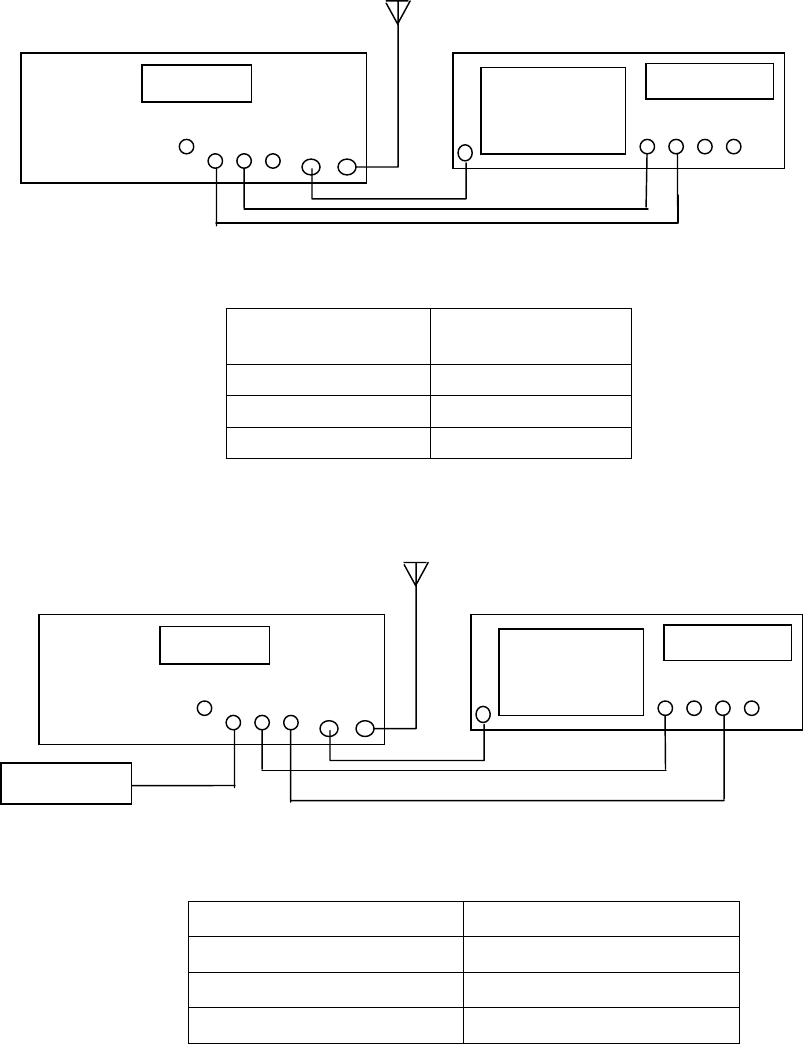
2-1
TEN-TEC
TRANS. TITAN II
TX OUT KEY IN
TX EN KEY OUT
ANTENNA TRANSCEIVER
FIGURE 1 - 1 T/R CONNECTIONS FOR TEN-TEC
TRANSCEIVERS WITH TX OUT & TX EN
OTHER TRANS. TITAN II
KEY KEY OUT
EXT. T/R N.O. RELAY PTT/VOX
ANTENNA TRANSCEIVER
FIGURE 1 - 2 T/R CONNECTIONS FOR OTHER TRANSCEIVERS
TITAN II OMNI VI
TITAN II OTHER RIG
CW KEYER
2-1
CHAPTER 2
OPERATING INSTRUCTIONS
2.1 INTRODUCTION : The following
instructions will enable the operator to
quickly place the TITAN II in operation.
included are descriptions of the front panel
controls and rear panel connections.
Followed by a detailed tune-up procedure.
Refer to Chapter 3 for further information
and operating hints.
2.2 FRONT PANEL CONTROLS :
The front panel controls and their
functions are described below.
2.2.1 BAND SWITCH : This switch
selects the desired frequency of operation.
This is a six position switch that covers the
160 meter to 10 meter bands. NOTE ; A
built in switch stop prevents operation in
the 10 and 12 meter bands. For 10 and 12
meter operation you must contact the
factory for an authorized modification kit.
2.2.2 TUNE : This control adjusts
variable capacitor C1 to provide resonance
at the operating frequency. Figure 2-4
(page 2-8) shows the approximate settings
for both the TUNE and LOAD controls
on each band. Keep in mind that the
settings in this chart are for operation into
an ideal 50 OHM load. On page 2-8 there
is a blank log chart that you may use to
record the actual control settings for your
antennas.
2.2.3 LOAD : This control adjusts
variable capacitor C2 for the proper
amplifier output loading. See the chart on
page 2-8.
2.2.4 POWER : This switch routes the
AC line to the primary of the low voltage
supply. When on , the TITAN II will
power up and the indicator light in the
switch will light.
2.2.5 OPR/STBY : This switch , when in
the OPERATE position , places the
amplifier online. When in the STBY
position , the amplifier is bypassed and
only the transceiver power is routed to the
antenna. When in the operate position the
indicator light in the switch will light.
2.2.6 QSK/PTT : This switch , when in
the QSK position , configures the key
circuits for CW/QSK operation. For late
model TEN-TEC transceivers with TXEN
and TX OUT , this position is used for all
modes of keying. When in the PTT
position , the key circuits are configured
for voice operation with other than TEN-
TEC transceivers.
2.2.7 MULTIMETER SWITCH : This
switch connects the right hand meter to
various monitoring sites in the amplifier.
A. Plate voltage Ep - When in this
position the meter reads plate
voltage. This voltage is line voltage
dependant at the ratio of 10 V plate
per 1 V line. Plate voltage is set to
3000 VDC at a line voltage of 240
VAC. Therefore at a line voltage of
250 VAC the meter will be a little
higher (3100 VDC). Since the
voltage is not critical , the meter is
marked with a general area (box) of
operation. As long as plate voltage is
somewhere in or over this box , the
TITAN II is happy.
B. Screen current Is - When in this
position , the meter is paralleled
with a resistor in series with the
screen supply. This monitors screen
grid current. The upper limit for
screen current is 75Ma. Always
operate below 75 Ma of screen grid
current. In addition to the analog
meter, the screen overdrive LED
indicates excessive screen current.
C. Forward power - When in this
position , the meter is connected to
2-2
a bridge circuit at the antenna
output. This measures forward
output RF power. It is, however,
more load dependant than an
external watt meter such as a Bird.
If your antenna is far from resonance
, the accuracy is not as good and
power measurements should be
made externally.
D. Reflected power REV- When in this
position, the meter is connected to
the
other port of the bridge at the
antenna output. The meter reads
reflected power (500 WATTS full
scale).
2.2.8 OVERDRIVE : These two LEDs
indicate grid overdrive conditions.
A. When the screen overdrive LED is lit,
the screen current is approaching or has
passed its limit. Reduce drive from the
transceiver immediately and retune.
B. When the control grid overdrive LED
is lit, the control grid current is
approaching or has passed its limit.
Reduce drive from the transceiver
immediately and retune.
2.2.9 WAIT : This LED indicates a 3
minutes warm-up period for the tube at
initial power up. After being turned on for
3 minutes, the wait LED goes out and the
TITAN II can be placed in the operate
mode.
2.2.10 PEAK POWER BARGRAPH :
This meter is connected to the bridge at
the antenna output through an emitter
follower
to monitor peak RF output power. When
the red LED is lit, 1500 WATTS has been
reached.
2.3 REAR PANEL CONNECTIONS
AND CONTROLS : The rear panel
connections and their functions are
described below.
2.3.1 TRANSCEIVER : This is a standard
SO-239 receptacle designed for a mating
PL-259 plug. RG-58U or similar 50 OHM
coax is required to connect the TITAN II
to the transceiver.
2.3.2 ANTENNA : This is a standard SO-
239 receptacle designed for a mating PL-
259 plug. RG-8X or similar 50 OHM coax
rated for 1500 WATTS is required for
connecting to the antenna.
2.3.3 KEY IN : This jack is the input for
the TITAN II transmit/receive relay
system. When used with all late model
TEN-TEC transceivers, this jack is
connected to the TX OUT connector on
the transceiver. When used with other
transceivers, a key or keyer is plugged
into this jack for CW operation.
2.3.4 KEY OUT : This jack is a protected
output from the TITAN II which passes
the key in to the transceiver after all relays
in the TITAN II have closed and it is
ready to transmit. When used with all late
model TEN-TEC transceivers , this jack is
connected to the TX EN on the
transceiver. When used with other
transceivers, this jack is connected to the
transceiver key input jack.
2.3.5 PTT/VOX : This jack is an input to
the TITAN II transmit/receive relay
circuits. When used with late model TEN-
TEC transceivers, this jack is not used.
When used with other transceivers, this
jack is connected to the N.O. contacts of
the relay key out jack of the transceiver.
2.3.6 ALC : This jack provides a negative
going ALC voltage , used primarily with
tube type transceivers.
2.3.7 ALC CONTROL : This control
adjusts the ALC voltage from
approximately -1 to -15 VDC
depending on RF input from the
transceiver.
2.3.8 AC LINE : This cable is connected
to a standard 240 VAC. Be sure the line
used to power the TITAN II is capable of
supplying 20 AMPS of current at 240
VAC, and that it is protected by either
2-2
fuses or circuit breakers of 20 AMPS. wire
size of the AC feed line should be at least
10/2 with ground
or larger.
2.3.9 LINE FUSES : Primary line fuses
(ABS-20) are accessible through these
panel fuse holders. Replace with ABS-20
or comparable fuses only.
2.4 INITIAL TURN-ON : The
following steps should be followed when
turning on your TITAN II.
A. Set multimeter switch to the Ep
plate voltage position.
B. Place the power switch to ON. If any
of the following do not occur, press
OFF at once and investigate before
proceeding.
1. The power switch light should
light.
2. The meter lights should light.
3. The fan motor should start and
air flow should be felt at the
exhaust port on top of the
amplifier.
4. The wait LED should light.
5. All meter indications are zero.
6. All other LEDs are not lit.
2.5 TUNE UP PROCEDURE : The
following section describes important
points to observe during tune up. A
suggested procedure for safely tuning up
the TITAN II is included.
2.5.1 CHECKS TO MAKE BEFORE
TUNING UP: Check the load connected
to the amplifier. This can best be done by
leaving the TITAN II in the BYPASS
mode and using only the transceiver
output power. Use a reliable SWR bridge
or watt meter to determine the SWR of the
load (antenna) connected to the amplifier.
If the reflected power is less than 10% of
the forward power , the VSWR is less
than 2:1. If the reflected power is 4% or
less, the VSWR is 1.5:1 or lower. A
VSWR of 2:1 or less is required.
2.5.2 IMPORTANT POINTS TO
REMEMBER: The most important
parameters to observe during tune up are
the currents in the control grid and the
screen grid. Excessive grid current even
for a relatively short period of time, can
and will damage the tube. If grid currents
are not exceeded, the 4CX1600B tube will
deliver many years of trouble free service.
In the TITAN II the control grid is
monitored by front panel LED indicator.
When control grid current is exceeded ,
the LED lights. Reduce the drive
immediately and retune the TITAN II.
Screen grid current is monitored by the
multimeter , when in the Is position and
by an LED overdrive indicator
continuously. Screen grid current should
be kept to a minimum during tune up and
always in a positive direction. When
screen current is exceeded the screen
overdrive LED will light. Reduce drive
immediately and re tune. After tune up ,
erratic lighting of either over drive
indicator could indicate breakdown in the
load (antenna components). Reduce drive
and check for arcing or heating of balluns,
coax or other elements.
2.5.3 SUGGESTED TUNE UP
PROCEDURE : Following is the
recommended procedure for safe and
proper tune up of the TITAN II .
A. Set the band switch to the desire
operating frequency.
B. Set the multimeter switch to the Ep
position.
C. Place the STBY/OPR switch to
OPR. The operate LED lights and
high voltage is indicated on the
multimeter (approximately 3000
VDC).
D. Set the meter switch to the Is
position. Always monitor Is with the
multimeter. Use FWD and REV
positions momentarily for checking
output power. Always monitor the
2-2
Overdrive LEDs and reduce drive
when either is lit.
E. For initial tune up you set the TUNE
and LOAD controls to their center
positions. Alternately you may refer
to the suggested settings in the chart
in figure 2-4. Keep in mind that
these settings are for operation into
an ideal 50 OHM load and may vary
slightly.
F. Turn the transceiver RF output
control to minimum. IF AT ANY
TIME THE TITAN II DOES NOT
RESPOND AS EXPECTED
remove drive immediately and
correct the problem before
continuing.
G. Key the transceiver and slowly
increase the drive power until you
see the plate current increase.
NOTE: To prevent sustained
arcs, use a keyer and a
string of dits at approximately
30 WPM.
H. Adjust the TUNE control for a peak
in plate current and a peak in RF
power output.
Adjust the LOAD control for a
minimum grid current. You will find
that these values are not always
synchronized. Choose the lower
grid current adjustment even if the
power output is slightly less.
Readjust the TUNE control for a
plate current peak each time you
adjust the LOAD control. There will
be some interaction between these
controls.
I. Gradually increase the drive level
from the transceiver until you reach
the desired output power level while
carefully touching up the TUNE and
LOAD controls for minimum grid
current and maximum output power.
J. Once you have the amplifier tuned up
and operating on the desired
frequency, you can log the LOAD
and TUNE settings in the chart
provided on page 2-9. These settings
will be repeatable for the same
frequency , antenna , and SWR
when used in the future.

2-3
CHAPTER 3
OPERATING HINTS
3.1 INTRODUCTION : The following paragraphs provide additional information for
getting the best performance from your TITAN II amplifier.
3.1.1 HIGH POWER TETRODE : The 4CX1600B is very rugged and normally operates
with a large margin of safety in the TITAN II . It will deliver outstanding service for many
years if not damaged by abuse...especially excessive grid current or blockage of cooling air
flow.
3.1.2 INTERLOCKS : The TITAN II is equipped with interlock switches intended to shut
off the power and short out the high voltage power supply when the cover is not securely
fastened in place. These protective interlocks are provided to protect you from
POTENTIALLY FATAL ELECTRIC SHOCK resulting from accidental contact with lethal
voltages inside the amplifier. However , you should never depend on interlocks alone to
protect you by removing dangerous voltages. ALWAYS DISCONNECT THE AC LINE
CABLE TO THE TITAN II BEFORE REMOVING THE TOP COVER.
3.1.3 FUSES : Except in rare instances of component failure , blowing one or both primary
fuses indicates that maximum safe average power capabilities of the amplifier have been
substantially exceeded.
3.1.4 TRANSFORMER RATINGS : The transformer in the TITAN II is rated at 2.5 KVA
CCS (continuous commercial service). It weighs 42 lbs. The weight of a transformer is
directly proportional to the capacity of that transformer. A 35 lb. transformer may be rated
higher by another manufactor but only if different standards are applied, such as heat rise.
Just for comparison , if our transformer was rated for IVS (intermittent voice service) or SSB
operation only, It would be 9 KVA. In summary , your power supply is more than adequate.
KEEP THE AIR INTAKE AND EXHAUST VENT AREAS
COMPLETELY CLEAR !!!
WARNING !!! DO NOT ALLOW THE SCREEN GRID
CURRENT TO EXCEED 55 Ma
WARNING !! THE AMPLIFIER SHOULD NEVER BE
ENERGIZED WITH THE COVERS REMOVED
DO NOT DEFEAT THE INTERLOCK SAFETY
SWITCHES
2-4
3.1.5 OPERATION ON 120 VAC : The
TITAN II is normally shipped from TEN-
TEC wired for operation on 240 VAC. The
power supplies in the TITAN II can be
modified for 120 VAC operation (but not
recommended). If you operate on 120 VAC ,
POWER OUTPUT MUST NOT EXCEED
1000 WATTS. To change the TITAN II for
operation on 120 VAC you will need the
following tools :
1 - medium size phillips screwdriver
1 - pair long nosed pliers
1 - soldering iron and solder
To perform the modification , refer to figure
3-1 and proceed as follows.
A. Make sure that the AC line is
unplugged and that all other cables are
disconnected.
B. Remove both bottom inspection plate
of the TITAN II.
C. Locate the (81815) Screen supply
board. There should be two jumper
wires already installed . For 120 VAC
terminals #1 and #4 are jumpered
together
D. Remove the jumper at #1 and move to
#5
E. Remove the jumper at #4 and move to
#7
F. Add jumper #10 between #4 and #1
G. Replace the inspection plate and
secure tightly.
H. The AC lines are still fused at 20
AMPS The internal wiring of the
TITAN II is not rated for full output at
120 VAC. NEVER EXCEED 1000
WATTS.
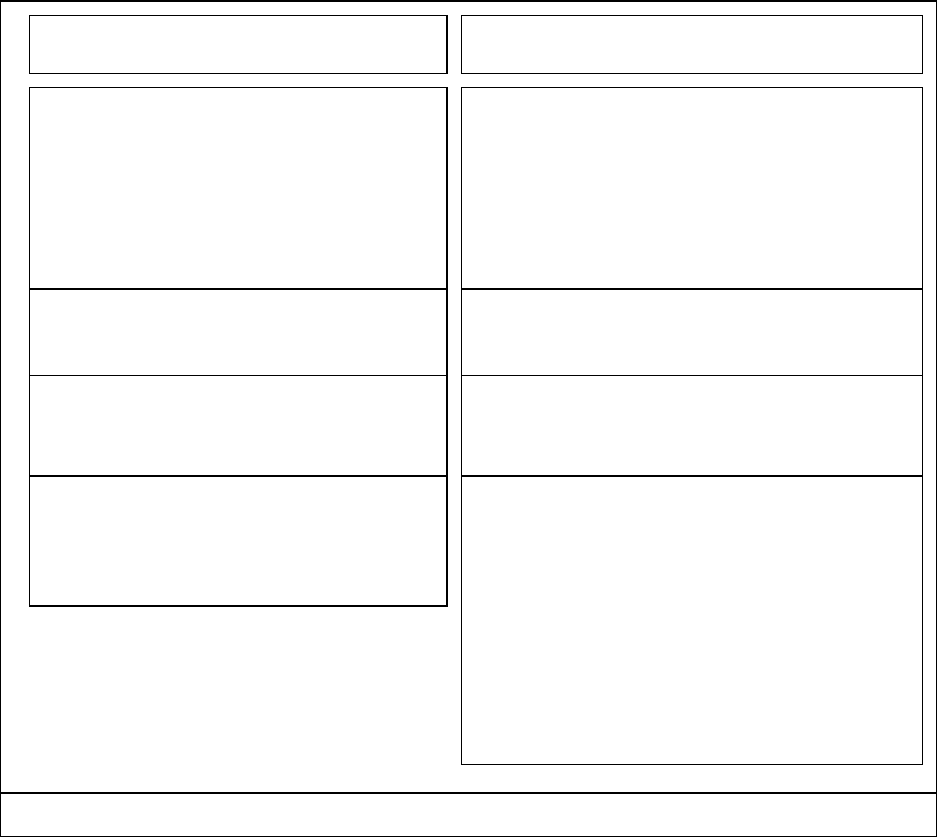
4-1
CHAPTER 4
MAINTENANCE AND TROUBLE SHOOTING
4-1 INTRODUCTION If you encounter
a problem , the troubleshooting hints
listed in TABLE 4-1 below will help
isolate the nature of the problem.
4-2 MAINTENANCE The amplifier
compartment , particularly areas around
high voltage components should be
cleaned frequently enough ( using a soft
bristled brush and vacuum cleaner ) to
prevent visible accumulation of dust. DO
NOT blow air directly into the fan input:
this con over rev the motor and damage
the bearings
SYMPTOM POSSIBLE CAUSE/CURE
1. Will not turn on: nothing happens
when the ON switch is activated. A] Fuse missing or open.
B] House wiring incorrect or breaker open.
C] Power cable to amplifier disconnected.
D] Fuse on HV-AC board (81810) open.
E] Problem with low voltage power supply
on QSK board (81814)
2. Lights turn on but no high voltage,
relays do not close. A] Interlock open, cover not tight
3. Relays K2 and K3 on HV-AC board
(81810) close but relay K1 does not.
Plate Voltage drops when RF is applied.
A] Q1 ON 81810 HV-AC BOARD IS
defective .
B] K1 on 81810 is defective.
4. Relays K1, K2, K3 on 81810 HV-AC
board close but no high voltage at turn
on.
A] K2 , K3 defective.
B] HV short to ground.
C] High voltage transformer disconnected.
D] High voltage bridge open.
CAUTION: NEVER TRUST ONLY ONE
HV METERING CIRCUIT. THERE
COULD BE HV PRESENT BUT THE
METER DOESN’T REGISTER IT.
ALWAYS DOUBLE CHECK WITH AN
EXTERNAL HV METER
TABLE 4-1 TROUBLE SHOOTING HINTS
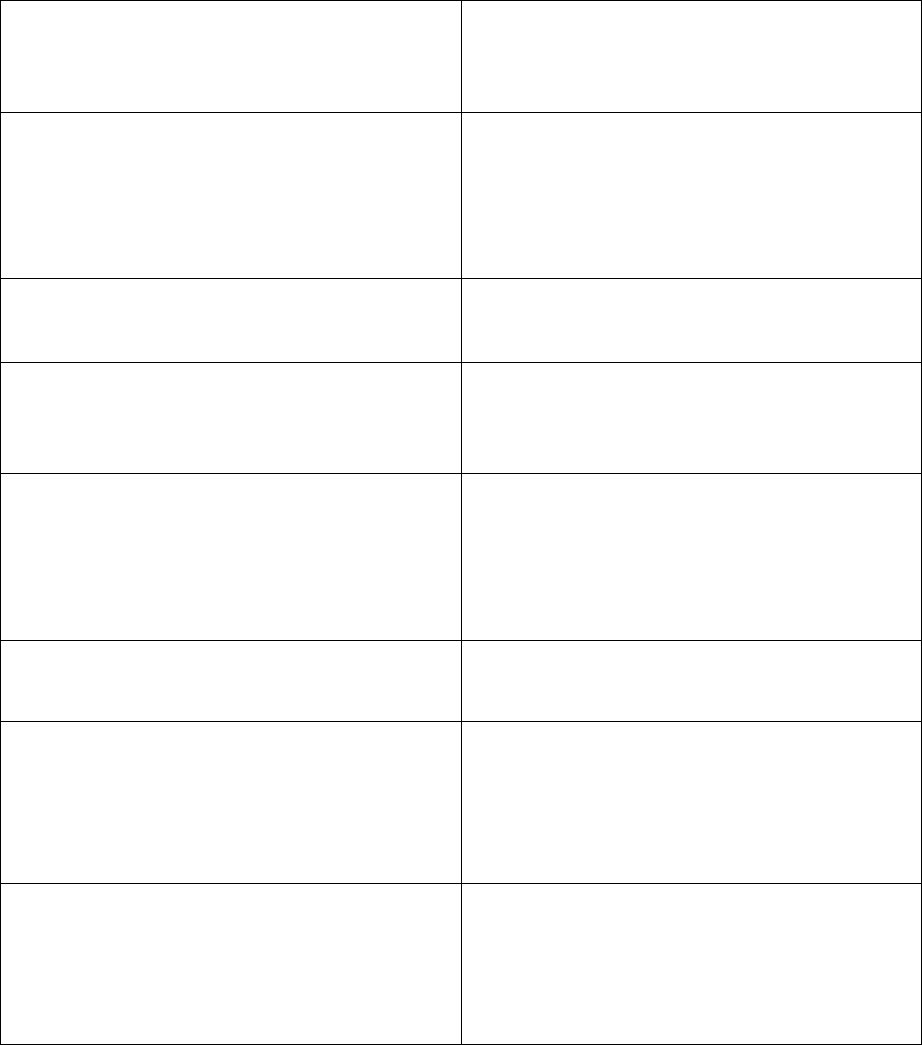
4-2
TABLE 4-1 TROUBLE SHOOTING HINTS ( Continued)
5. Relays K1, K2, and K3 close at turn on ,
but line fuses blow. A] High voltage at crowbar or elsewhere.
B] Shorted tube.
C] Leaky electrolytics in high voltage
supply.
6. Amplifier won’t drive , zero grid and plate
current , High input SWR . A] Defective cable from transceiver to
amplifier.
B] Input relay K2 on 81816 SWR board
defective.
C] Input filter on 81811 input matching
board loose or damaged.
7. Grid over drive led lights with no drive. A] Q7 on 81815 shorted or leaky.
B] Shorted or leaky tube.
8. Screen over drive led lights with no drive. A] R23 on 81815 board open or increased in
value.
B] Low or no high voltage. TURN OFF THE
AMPLIFIER IMMEDIATELY.
9. Amplifier difficult to drive , little or no
output , high plate current (may be
accompanied by a “frying sound”).
A] Band switch in wrong position.
B] Excessively high load SWR.
C] Defective output relay on 81816 SWR
board.
D] Arcing in tank circuit or antenna feed
line.
10. Excessive plate current in receive mode. A] Defective bias circuit on 81814 board.
B] Shorted grid /cathode in tube.
11. Transceiver does not key using key-
in/key-out loop. A] Key-in and key-out lines reversed at
amplifier or at Transceiver.
B] Defective key line cables.
C] Defective relay control circuit on 81814
QSK board.
12. Transceiver stays keyed in receive mode.
May be accompanied by loss of receive
signal.
A] Relay K1 on 81816 SWR board stuck.
B] Shorted key-in or key-out cable.
C] Defective relay control circuit on 81814
QSK board.
5-1
CHAPTER 5
CIRCUIT DESCRIPTIONS AND ILLUSTRATIONS
5-1 INTRODUCTION The following sections contain detailed circuit board subassemblies
used in the Model 416 Linear Amplifier. Also included are circuit trace drawings and
detailed component layout diagrams. These drawings are followed by schematic diagrams for
each circuit board subassembly. In addition , there is an overall wiring diagram for the
Model 416 Amplifier.
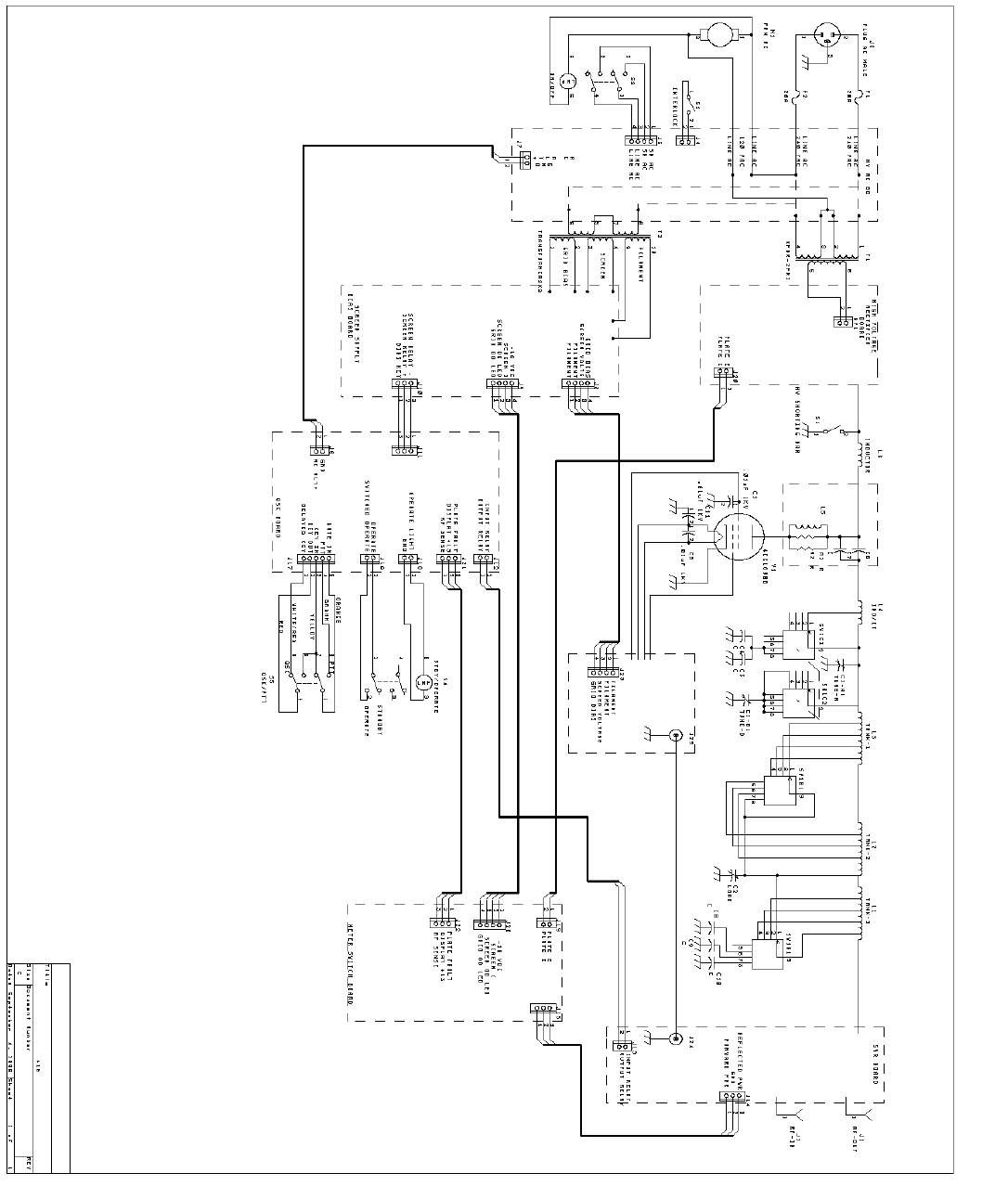
5-2
5-3
INPUT MATCHING BOARD (81811)
This board contains the input filter,
impedance matching networks , and ALC
circuits.
The input filter network (81550) is the
standard input filter shipped with the
TITAN II. This is a five pole elliptic filter
consisting of L1,L2,L3,C1,C2, and C3.
This filter provides increased roll-off of
frequencies above the 15M band. An
optional 15/10M INPUT FILTER
BOARD (81840) is available from TEN-
TEC to qualified amateur radio operators,
upon receipt of a copy of their amateur
radio license. Note: Operation on the
10m band will also require additional
modifications to the bandswitch
assembly. Please contact the factory for
instructions or further information.
The impedance matching network of
resistors R5 –R40 match the input
impedance of the 4CX1600B to the input
filter board.
The ALC circuit samples the input RF
power to the amplifier. D1 rectifies this
sample and produces a negative voltage
proportional to input power for control of
some exciters.
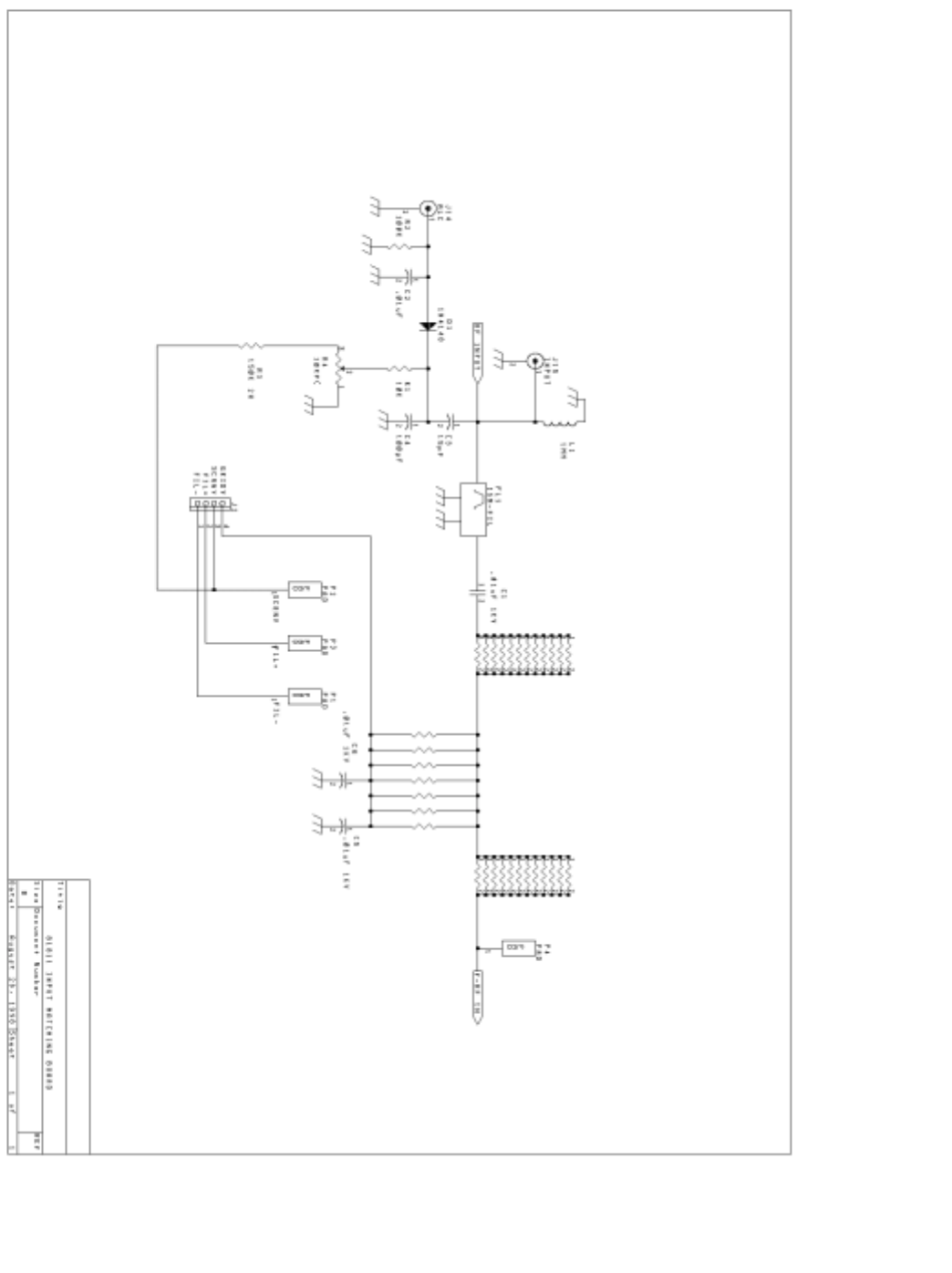
5-4
5-5
81809 H.V. POWER SUPPLY BOARD This board contains the high voltage rectifier
bridge (D1 – D20),H.V. filters (C1 – C9), and H.V. meter circuits (Voltage and current).
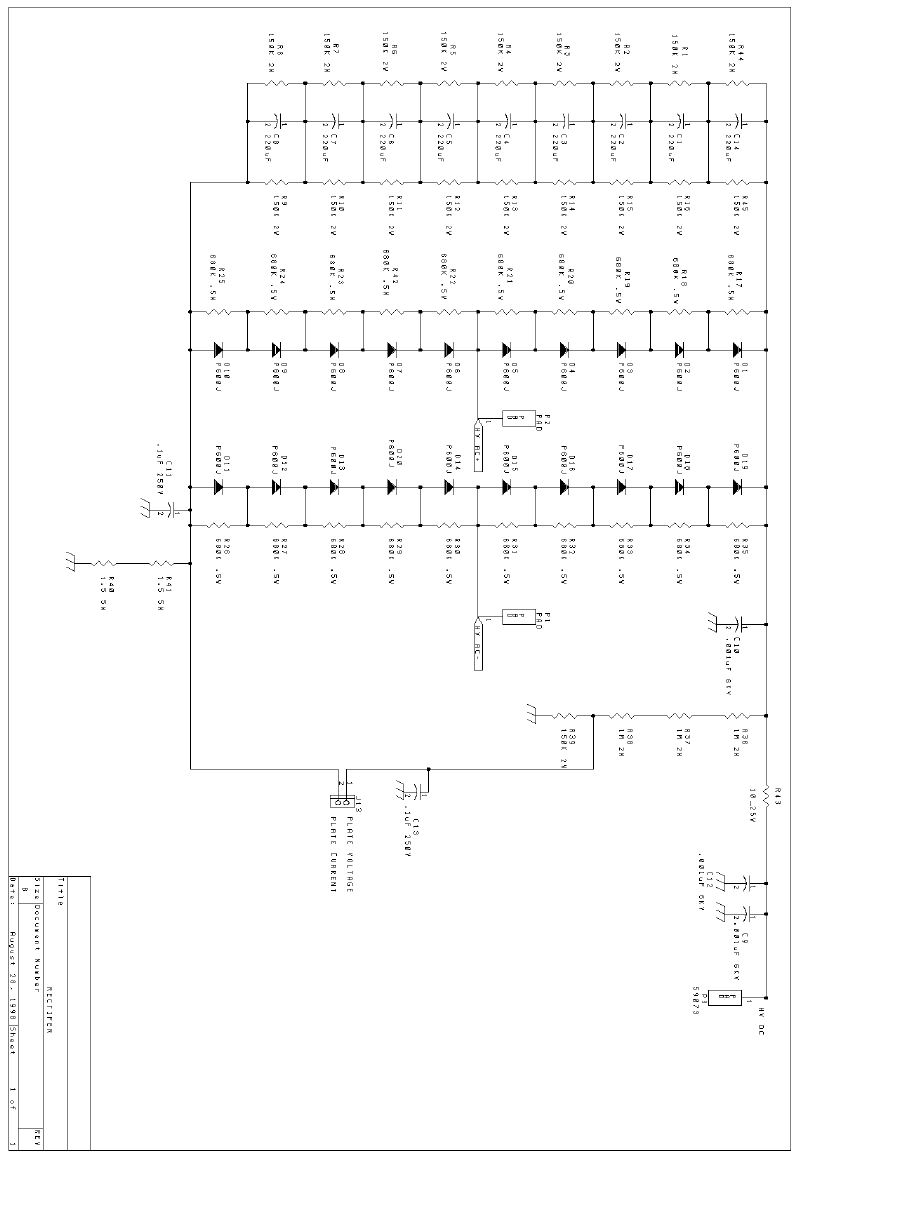
5-6
5-7
81815 SCREEN SUPPLY AND GRID BIAS BOARD This board contains the screen
supply ,grid bias supply, and protective circuits for the 4CX1600B.
The screen voltage is rectified by diodes D4 – D7 and filtered by C1 – C4. This DC voltage
is then regulated by pass elements Q9,Q5,Q6, and Q8. Load resistors R25 – R27 provide a
current drain to insure screen current remains in the positive direction.. MOV Z1 protect the
power supply in the event of tube arc and insures the screen voltage can’t surge above 450
VDC. R23 provides a voltage drop proportional to the screen current to drive the front panel
screen current meter.
The grid bias voltage is rectified by D13 then filtered by C10. Q1 senses the key condition
and switches zener diodes D2 and D8 in during key down and out during key up. This zeners
the bias voltage to –50 VDC during TX and –130 VDC in RX. The circuitry of Q7 senses
grid current and begins to fold back grid bias toward cutoff as grid current approaches 2
watts.
Zener diode D1 provides regulation for the negative 16 VDC power supply to run the meter
circuits on the meter switch board.
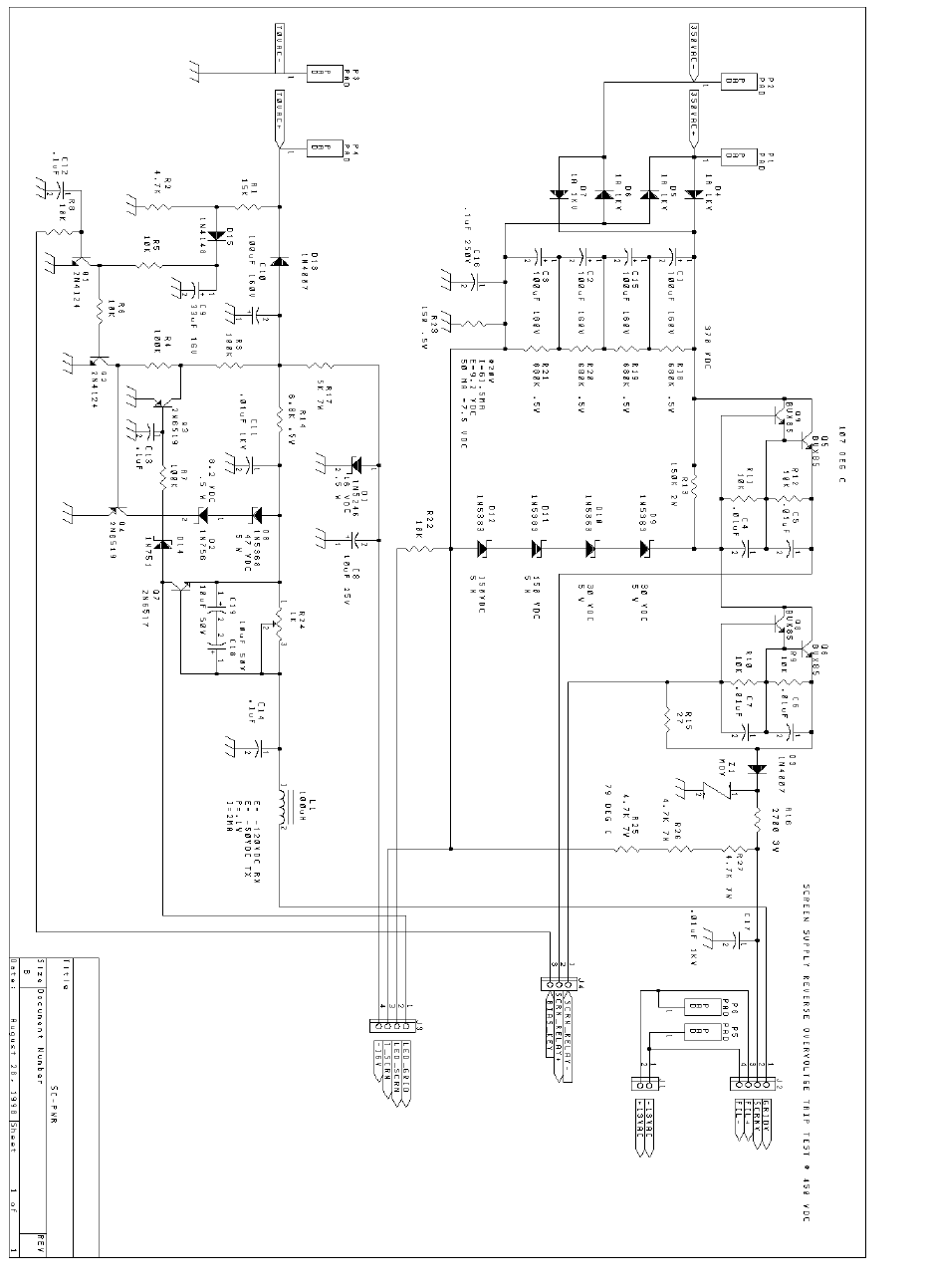
5-8
5-9
81814 QSK BOARD This board contains the low voltage supply , turn-on relay
sequencing circuits , and T/R relay control.
The low voltage is rectified by D1 – D4 and filtered by C6. U1 and Q4 provide regulation
for all low voltage circuits except the negative 16 VDC supply.
After a 3 minute warm-up period determined by RC time constant of R5 and C5 ,Q12 will
fire turning on the pass element Q7. This initiates amplifier power up. When the operate
switch is put in the operate position this voltage is applied to relay sequencing circuits of
Q5,Q15, and Q13.
These circuits insure plate and screen voltages arrive at and leave the tube in the proper
order. Q18 senses plate current and disables the amplifier when plate current e parameters are
exceeded (such as excessive plate current during a tube arc).Both plate voltage and screen
voltage are removed when plate current of 1.2 AMPs is reached.
U2 and U3 are the gated array that controls the input and output relays. This circuit
samples input key requests , standby/operate modes, power on/off state and RF presence at
the antenna connection. Hot switch protection is provided regardless of mode. In the QSK
mode, using the key in / key out loop , the key in request from the transceiver is tailored by
U1 and U2 to insure smooth QSK action of the input and output relays.
K1 senses power off and places the key circuit in bypass mode for operation in barefoot
mode.
K2 senses Operate/standby mode and routes the key request either to the amplifier control
circuit in Operate mode, or to the key out jack in the standby mode.
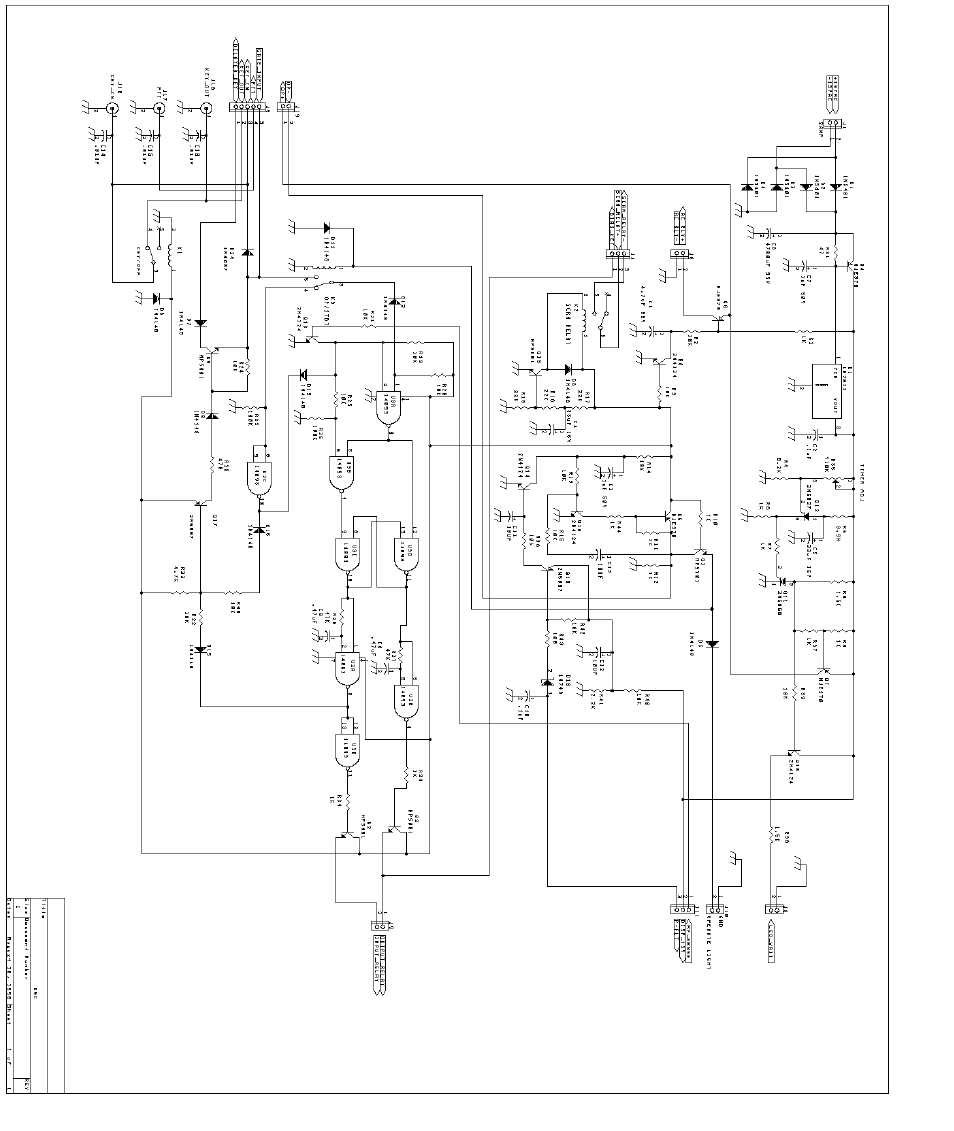
5-10
5-11
81816 SWR BOARD This board contains the input relay, output relay, and the swr bridge
for output power measurement.
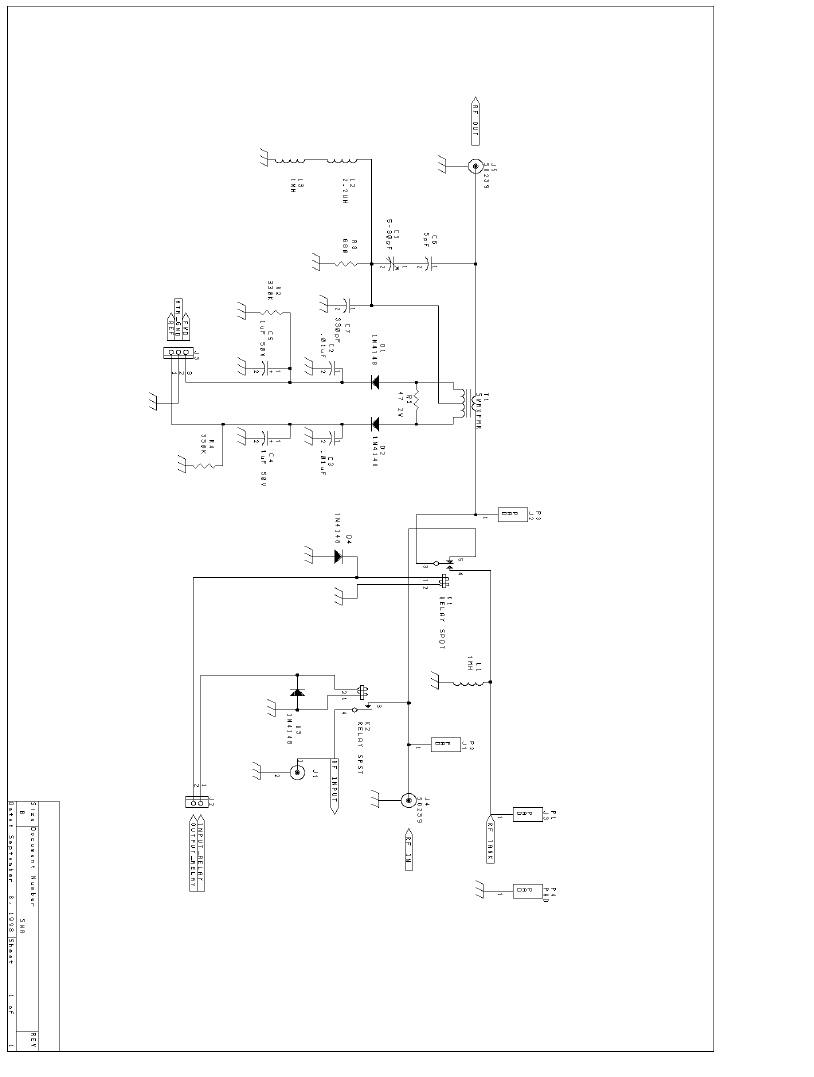
5-12

5-13
81813 PLATE BOARD This board contains the parasitic suppressors and coupling
capacitors to connect the 4CX1600b plate to the amplifier tank circuit.
5-15
81812 METER SWITCH BOARD This board contains the metering circuits for the front
panel meters. SW1 selects the parameter to be monitored. This selection is then sent to M2.
The multimeter has three calibrated scales for measuring either plate voltage, screen current
or RF power (forward or reverse).
U1 samples screen and control grid current and drives the appropriate LED to indicate
excessive current of either screen or control grid.
Q1 samples forward RF power voltage from the SWR board. This voltage is peaked by
C8 and sent to U2 to drive the peak reading display.
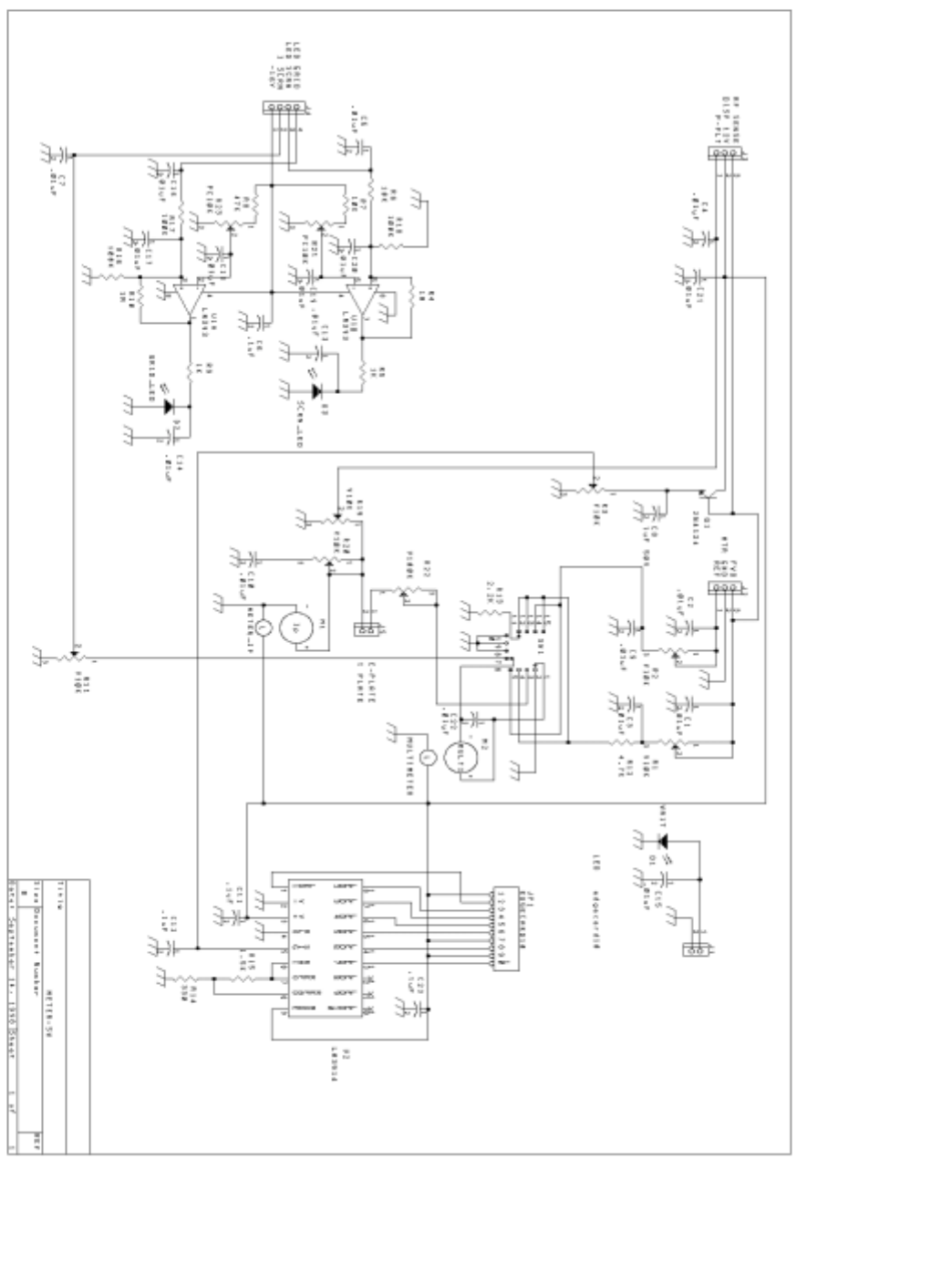
5-15
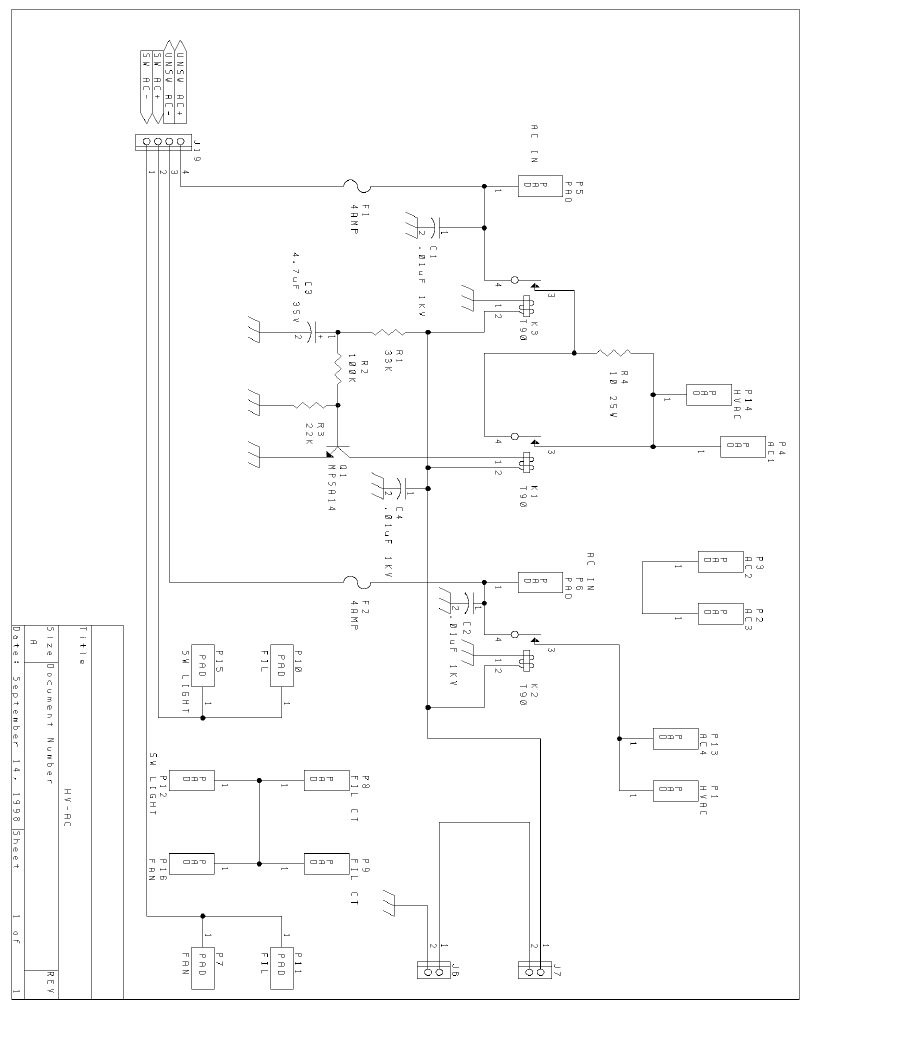
5-16
81810 AC LINE DELAY BOARD This board contains the step start relays and associated
circuitry to control inrush current while the H.V. filter capacitors charge.